-
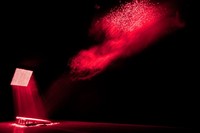 V
V Li Hui’s latest installation, V, is composed of two ephemeral elements and one tangible one: red lasers, smoke, and a mirror. The mass of laser beams form the shape of a V as they shine down onto the mirror, which is propped up at an angle from the floor. The mirror then reflects the rays back up through the smoke-filled room: They trace lines in space en route to the ceiling far above, where they seem to congeal as a cluster of little red dots. Puzzled at first by this object that strikes through the darkened room, many visitors then begin to wave their arms through the laser beams, causing their moving silhouettes to register on the ceiling as the dots of light blink and reappear.
While V arguably constitutes more a reassembly of media than evidence of formal development in terms of Li’s artistic practice, it nonetheless retains an ability to mystify its audience. This mystique has cushioned Li’s works with a cultish admiration, and like his previous installations, V certainly occupies the realm of spectacle, pointing to the artist himself as director of intense sensory experiences.
-
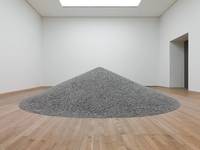 Sunflower Seeds
Sunflower Seeds Sunflower Seeds 2010 consists of millions of individually handcrafted porcelain sunflower seeds. The work has a volume of nearly ten cubic metres, weighing approximately ten tonnes. The artist has stipulated two different configurations for the work. In the first, the seeds are arranged in a continuous rectangular or square field to a depth of ten centimetres. This ‘bed’ of seeds conforms to the dimensions of the display space, with walls confining the work on three sides. Alternatively, the work is presented as a conical sculptural form, approximately five metres in diameter. In this second configuration, there is no containing structure or support for the conical form, which is installed by carefully pouring the seeds from above to form the shape. Any uneven edges can be adjusted by hand at the time of installation.
-
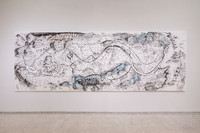 Map of the Theater of the World
Map of the Theater of the World Qiu created Map of “Art and China after 1989: Theater of the World,” a five-panel ink-on-paper map that charts the history of art and political movements covered in the exhibition.3 Qiu is well suited for this task; he has made many conceptual maps that diagram ideas and concepts rather than physical places.
Mapmaking is one of the fundamental ways humans are able to imagine the world. Through maps, the unknown is made visible and understandable. Qiu uses the histories and techniques of mapmaking together with an ancient Chinese tradition of mapping imaginary places to create a conceptual territory that represents the subject matter and time period of the exhibition.
-
 Gravitational Arena
Gravitational Arena This installation art is founded on the law of perspective, but it does not end with visuality.
Stretched by gravity, this sky-dimming “Square Word Calligraphy” reaches to the ground. While creating a distorted textual space, it simultaneously puts the viewers into a tension between “seeing” and “reading”.
-
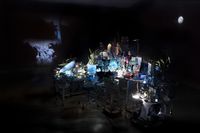 Timekeeper
Timekeeper The sculpture that is the central component of Sze’s exhibition — blurs the line between organic and mechanical structure, its lifecycle marked by clicking and whirring and flickering images. It keeps a form of eccentric time that is entirely its own, remembering moments over and over again as time slips by. In this sense, Timekeeper has no relationship to the mechanical devices we use to mark the literal passing of time, but instead to the way we recall and replay our lives, in selected fragments that, strung together, account for the passage of years.
-
 Shibboleth
Shibboleth Shibboleth I is a medium-size digital photograph by the Colombian artist Doris Salcedo that depicts the Turbine Hall of Tate Modern, London, with a long narrow crack running along its floor. The print is part of a portfolio of four photographs each showing different views of the same scene, including Shibboleth II (Tate P20335), Shibboleth III (Tate P20336) and Shibboleth IV (Tate P20337), and the portfolio as a whole is number one in an edition of forty-five plus ten artist’s proofs. The photographs were made as part of Salcedo’s 2007 installation project for the Unilever Series at Tate Modern, also titled Shibboleth, which involved the artist creating a deep fissure in the floor of the Turbine Hall that stretched from one end of the gallery to the other, into which she placed a concrete cast of a Colombian rock face with a wire chain-link fence set into it. These photographs are digital composites made up of images of the Turbine Hall seen from four different angles and photographs that Salcedo took of a small-scale model of the cracked floor that she made in her studio in Bogotá, Colombia.
-
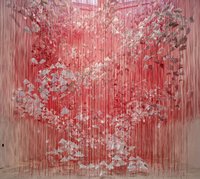 Letter of Love
Letter of Love Confronting fundamental human concerns such as life, death and relationships, Shiota explores human existence throughout various dimensions by creating an existence in the absence either in her large-scale thread installations that include a variety of common objects and external memorabilia or through her drawings, sculptures, photography and videos.
-
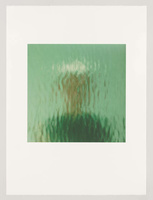 Reflection
Reflection The image is a reflection of the artist in the multiple layers glass that were stacked in preparation for the construction of a gridded wall across the entire facade of the United States Pavilion in Venice. Recorded at five-minute intervals, the series documented the shifting weather seen through the newly uncovered pavilion skylights.
-
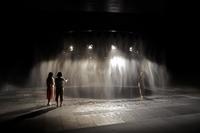 Rainbow Assembly
Rainbow Assembly Rays of light illuminate a circle of mist in a darkened room, creating shimmering rainbows in the air. Approaching the rainbows, you discover the machinery that produces them: rings of sprinklers and spotlights on the ceiling. An important feature of Eliasson’s works is that the mechanisms that produce them are never hidden, but always exposed. In this way, the works are not illusions that deceive and seduce the viewer, but rather demonstrations of how reality is always constructed.
-
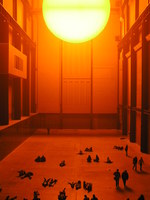 The Weather Project
The Weather Project Created for the Turbine Hall of Tate Modern, London, this site-specific installation employed a semi-circular screen, a ceiling of mirrors, and artificial mist to create the illusion of a sun. Aluminium frames lined with mirror foil were suspended from the ceiling to create a giant mirror that visually doubled the volume of the hall – along with the semi-circular screen mounted on the far wall, its long edge abutting the mirror ceiling. Backlit by approximately 200 mono-frequency lights, the semi-circle and its reflection created the image of a massive, indoor sunset seen through the artificial mist emitted into the room. By walking to the far end of the hall, visitors could see how the sun was constructed, and the reverse of the mirror structure was visible from the top floor of the museum.
-
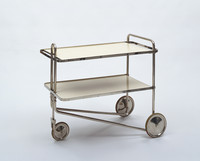 Tea Cart (model B54)
Tea Cart (model B54) The Marcel Breuer Tea Cart (model B54) first appeared in the form of a prototype in a photograph dated 1928. The Marcel Breuer cart was first shown in public in 1930 at the Salon des Artiste Decorateurs where Breuer designed an "apartment for a boardinghouse/hotel" as a representative of Deutscher Werkbund. The cart made another public appearance in 1932 when Marcel Breuer designed a house for the Berlin-Bau Austellung known as the "House for Sportsmen."
-
 Bauhaus Stairway
Bauhaus Stairway The Bauhaus school was premised on a utopian vision of society based on the integration of technology, art, design, and life. Originally founded in 1919 by architect Walter Gropius in Weimar, Germany, the school moved to Dessau in 1925 and finally to Berlin in 1932. Schlemmer, who taught at the school from 1920 to 1929, made Bauhaus Stairway in response to an announcement that, under pressure from the Nazi party, the school was to close. The Bauhaus shut its doors in 1933, the year after he created this painting.
-
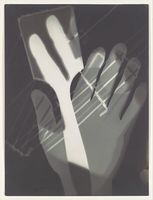 Fotogramm
Fotogramm Moholy-Nagy played a key role at the Bauhaus in Weimar and Dessau as a painter, graphic artist, teacher, and impassioned advocate of avant-garde photography. He made this image without a camera by placing ordinary objects, including his hand and a paintbrush, on a sheet of photosensitized paper and exposing it to light.
-
 Red Balloon
Red Balloon The artist often transformed his experiments in tonal value and line into visual anecdotes. Red Balloon, for example, is at once a cluster of delicately colored, floating geometric shapes and a charming cityscape. Runner at the Goal is an essay in simultaneity; overlapping and partially translucent bars of color illustrates the consecutive gestures of a figure in motion. The flailing arms and sprinting legs add a comic touch to this figure, on whose forehead the number “one” promises a winning finish.
-
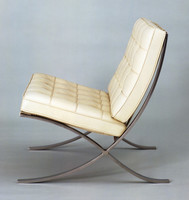 Barcelona Chair
Barcelona Chair The Barcelona Chair achieves the serenity of line and the refinement of proportions and materials characteristic of Mies van der Rohe's highly disciplined architecture. It is supported on each side by two chrome-plated, flat steel bars. Seen from the side, the single curve of the bar forming the chair's back and front legs crosses the S-curve of the bar forming the seat and back legs, making an intersection of the two. This simple shape derives from a long history of precedents, from ancient Egyptian folding stools to nineteenth-century neoclassical seating. The cantilevered seat and the back of the original chairs were upholstered in white kid leather with welt and button details.
-
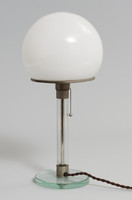 Table Lamp
Table Lamp The table lamp's working parts are visible; the opaque glass shade, a type formerly used only for industrial lighting, helps to diffuse the light.
-
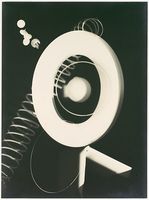 Rayograph
Rayograph Man Ray made his "rayographs" without a camera by placing objects-such as the thumbtacks, coil of wire, and other circular forms used here-directly on a sheet of photosensitized paper and exposing it to light.
-
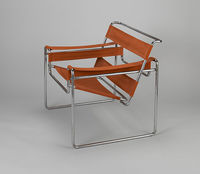 The Wassily Armchair
The Wassily Armchair The Wassily armchair (also known as Model B3 chair) designed by Marcel Breuer that features a tubular chromed-steel structure and strips of leather used as seat, back, and arm support. This chair is often used as a prime example of the design aesthetic of the Bauhaus during this period, and of mid-20th century modernist design in general, due to the innovation of the use of tubular steel in its construction.
-
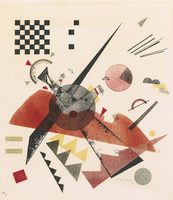 Orange
Orange Kandinsky made these two works when he was a teacher at the Bauhaus, the innovative and influential modernist art and architecture school in Germany, where he began working in 1922. His work during this period was characterized by precise lines and dense groups of simple geometric shapes arranged without any central focus. In his writings Kandinsky analyzed the geometrical elements and the various ways that their color, placement, and interaction could affect the viewer, both physically and spiritually. He considered the circle to be the most elementary form, possessing a cosmic meaning.
-
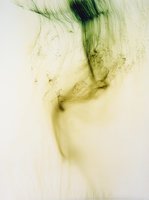 Free Swimmer 54
Free Swimmer 54 Traces of color and abstract structures. Tillmans made this work – the result of a photochemical process using neither a camera nor a negative – in the darkroom. From the purely technical standpoint, it is a photograph but does not represent anything specific. It is a form of non-representational photograph with which Tillmans prompts us to change our seeing habits: the continuation of painting with photographic means.
 V Li Hui’s latest installation, V, is composed of two ephemeral elements and one tangible one: red lasers, smoke, and a mirror. The mass of laser beams form the shape of a V as they shine down onto the mirror, which is propped up at an angle from the floor. The mirror then reflects the rays back up through the smoke-filled room: They trace lines in space en route to the ceiling far above, where they seem to congeal as a cluster of little red dots. Puzzled at first by this object that strikes through the darkened room, many visitors then begin to wave their arms through the laser beams, causing their moving silhouettes to register on the ceiling as the dots of light blink and reappear. While V arguably constitutes more a reassembly of media than evidence of formal development in terms of Li’s artistic practice, it nonetheless retains an ability to mystify its audience. This mystique has cushioned Li’s works with a cultish admiration, and like his previous installations, V certainly occupies the realm of spectacle, pointing to the artist himself as director of intense sensory experiences.
V Li Hui’s latest installation, V, is composed of two ephemeral elements and one tangible one: red lasers, smoke, and a mirror. The mass of laser beams form the shape of a V as they shine down onto the mirror, which is propped up at an angle from the floor. The mirror then reflects the rays back up through the smoke-filled room: They trace lines in space en route to the ceiling far above, where they seem to congeal as a cluster of little red dots. Puzzled at first by this object that strikes through the darkened room, many visitors then begin to wave their arms through the laser beams, causing their moving silhouettes to register on the ceiling as the dots of light blink and reappear. While V arguably constitutes more a reassembly of media than evidence of formal development in terms of Li’s artistic practice, it nonetheless retains an ability to mystify its audience. This mystique has cushioned Li’s works with a cultish admiration, and like his previous installations, V certainly occupies the realm of spectacle, pointing to the artist himself as director of intense sensory experiences. Sunflower Seeds Sunflower Seeds 2010 consists of millions of individually handcrafted porcelain sunflower seeds. The work has a volume of nearly ten cubic metres, weighing approximately ten tonnes. The artist has stipulated two different configurations for the work. In the first, the seeds are arranged in a continuous rectangular or square field to a depth of ten centimetres. This ‘bed’ of seeds conforms to the dimensions of the display space, with walls confining the work on three sides. Alternatively, the work is presented as a conical sculptural form, approximately five metres in diameter. In this second configuration, there is no containing structure or support for the conical form, which is installed by carefully pouring the seeds from above to form the shape. Any uneven edges can be adjusted by hand at the time of installation.
Sunflower Seeds Sunflower Seeds 2010 consists of millions of individually handcrafted porcelain sunflower seeds. The work has a volume of nearly ten cubic metres, weighing approximately ten tonnes. The artist has stipulated two different configurations for the work. In the first, the seeds are arranged in a continuous rectangular or square field to a depth of ten centimetres. This ‘bed’ of seeds conforms to the dimensions of the display space, with walls confining the work on three sides. Alternatively, the work is presented as a conical sculptural form, approximately five metres in diameter. In this second configuration, there is no containing structure or support for the conical form, which is installed by carefully pouring the seeds from above to form the shape. Any uneven edges can be adjusted by hand at the time of installation. Map of the Theater of the World Qiu created Map of “Art and China after 1989: Theater of the World,” a five-panel ink-on-paper map that charts the history of art and political movements covered in the exhibition.3 Qiu is well suited for this task; he has made many conceptual maps that diagram ideas and concepts rather than physical places. Mapmaking is one of the fundamental ways humans are able to imagine the world. Through maps, the unknown is made visible and understandable. Qiu uses the histories and techniques of mapmaking together with an ancient Chinese tradition of mapping imaginary places to create a conceptual territory that represents the subject matter and time period of the exhibition.
Map of the Theater of the World Qiu created Map of “Art and China after 1989: Theater of the World,” a five-panel ink-on-paper map that charts the history of art and political movements covered in the exhibition.3 Qiu is well suited for this task; he has made many conceptual maps that diagram ideas and concepts rather than physical places. Mapmaking is one of the fundamental ways humans are able to imagine the world. Through maps, the unknown is made visible and understandable. Qiu uses the histories and techniques of mapmaking together with an ancient Chinese tradition of mapping imaginary places to create a conceptual territory that represents the subject matter and time period of the exhibition. Gravitational Arena This installation art is founded on the law of perspective, but it does not end with visuality. Stretched by gravity, this sky-dimming “Square Word Calligraphy” reaches to the ground. While creating a distorted textual space, it simultaneously puts the viewers into a tension between “seeing” and “reading”.
Gravitational Arena This installation art is founded on the law of perspective, but it does not end with visuality. Stretched by gravity, this sky-dimming “Square Word Calligraphy” reaches to the ground. While creating a distorted textual space, it simultaneously puts the viewers into a tension between “seeing” and “reading”. Timekeeper The sculpture that is the central component of Sze’s exhibition — blurs the line between organic and mechanical structure, its lifecycle marked by clicking and whirring and flickering images. It keeps a form of eccentric time that is entirely its own, remembering moments over and over again as time slips by. In this sense, Timekeeper has no relationship to the mechanical devices we use to mark the literal passing of time, but instead to the way we recall and replay our lives, in selected fragments that, strung together, account for the passage of years.
Timekeeper The sculpture that is the central component of Sze’s exhibition — blurs the line between organic and mechanical structure, its lifecycle marked by clicking and whirring and flickering images. It keeps a form of eccentric time that is entirely its own, remembering moments over and over again as time slips by. In this sense, Timekeeper has no relationship to the mechanical devices we use to mark the literal passing of time, but instead to the way we recall and replay our lives, in selected fragments that, strung together, account for the passage of years. Shibboleth Shibboleth I is a medium-size digital photograph by the Colombian artist Doris Salcedo that depicts the Turbine Hall of Tate Modern, London, with a long narrow crack running along its floor. The print is part of a portfolio of four photographs each showing different views of the same scene, including Shibboleth II (Tate P20335), Shibboleth III (Tate P20336) and Shibboleth IV (Tate P20337), and the portfolio as a whole is number one in an edition of forty-five plus ten artist’s proofs. The photographs were made as part of Salcedo’s 2007 installation project for the Unilever Series at Tate Modern, also titled Shibboleth, which involved the artist creating a deep fissure in the floor of the Turbine Hall that stretched from one end of the gallery to the other, into which she placed a concrete cast of a Colombian rock face with a wire chain-link fence set into it. These photographs are digital composites made up of images of the Turbine Hall seen from four different angles and photographs that Salcedo took of a small-scale model of the cracked floor that she made in her studio in Bogotá, Colombia.
Shibboleth Shibboleth I is a medium-size digital photograph by the Colombian artist Doris Salcedo that depicts the Turbine Hall of Tate Modern, London, with a long narrow crack running along its floor. The print is part of a portfolio of four photographs each showing different views of the same scene, including Shibboleth II (Tate P20335), Shibboleth III (Tate P20336) and Shibboleth IV (Tate P20337), and the portfolio as a whole is number one in an edition of forty-five plus ten artist’s proofs. The photographs were made as part of Salcedo’s 2007 installation project for the Unilever Series at Tate Modern, also titled Shibboleth, which involved the artist creating a deep fissure in the floor of the Turbine Hall that stretched from one end of the gallery to the other, into which she placed a concrete cast of a Colombian rock face with a wire chain-link fence set into it. These photographs are digital composites made up of images of the Turbine Hall seen from four different angles and photographs that Salcedo took of a small-scale model of the cracked floor that she made in her studio in Bogotá, Colombia. Letter of Love Confronting fundamental human concerns such as life, death and relationships, Shiota explores human existence throughout various dimensions by creating an existence in the absence either in her large-scale thread installations that include a variety of common objects and external memorabilia or through her drawings, sculptures, photography and videos.
Letter of Love Confronting fundamental human concerns such as life, death and relationships, Shiota explores human existence throughout various dimensions by creating an existence in the absence either in her large-scale thread installations that include a variety of common objects and external memorabilia or through her drawings, sculptures, photography and videos. Reflection The image is a reflection of the artist in the multiple layers glass that were stacked in preparation for the construction of a gridded wall across the entire facade of the United States Pavilion in Venice. Recorded at five-minute intervals, the series documented the shifting weather seen through the newly uncovered pavilion skylights.
Reflection The image is a reflection of the artist in the multiple layers glass that were stacked in preparation for the construction of a gridded wall across the entire facade of the United States Pavilion in Venice. Recorded at five-minute intervals, the series documented the shifting weather seen through the newly uncovered pavilion skylights. Rainbow Assembly Rays of light illuminate a circle of mist in a darkened room, creating shimmering rainbows in the air. Approaching the rainbows, you discover the machinery that produces them: rings of sprinklers and spotlights on the ceiling. An important feature of Eliasson’s works is that the mechanisms that produce them are never hidden, but always exposed. In this way, the works are not illusions that deceive and seduce the viewer, but rather demonstrations of how reality is always constructed.
Rainbow Assembly Rays of light illuminate a circle of mist in a darkened room, creating shimmering rainbows in the air. Approaching the rainbows, you discover the machinery that produces them: rings of sprinklers and spotlights on the ceiling. An important feature of Eliasson’s works is that the mechanisms that produce them are never hidden, but always exposed. In this way, the works are not illusions that deceive and seduce the viewer, but rather demonstrations of how reality is always constructed. The Weather Project Created for the Turbine Hall of Tate Modern, London, this site-specific installation employed a semi-circular screen, a ceiling of mirrors, and artificial mist to create the illusion of a sun. Aluminium frames lined with mirror foil were suspended from the ceiling to create a giant mirror that visually doubled the volume of the hall – along with the semi-circular screen mounted on the far wall, its long edge abutting the mirror ceiling. Backlit by approximately 200 mono-frequency lights, the semi-circle and its reflection created the image of a massive, indoor sunset seen through the artificial mist emitted into the room. By walking to the far end of the hall, visitors could see how the sun was constructed, and the reverse of the mirror structure was visible from the top floor of the museum.
The Weather Project Created for the Turbine Hall of Tate Modern, London, this site-specific installation employed a semi-circular screen, a ceiling of mirrors, and artificial mist to create the illusion of a sun. Aluminium frames lined with mirror foil were suspended from the ceiling to create a giant mirror that visually doubled the volume of the hall – along with the semi-circular screen mounted on the far wall, its long edge abutting the mirror ceiling. Backlit by approximately 200 mono-frequency lights, the semi-circle and its reflection created the image of a massive, indoor sunset seen through the artificial mist emitted into the room. By walking to the far end of the hall, visitors could see how the sun was constructed, and the reverse of the mirror structure was visible from the top floor of the museum. Tea Cart (model B54) The Marcel Breuer Tea Cart (model B54) first appeared in the form of a prototype in a photograph dated 1928. The Marcel Breuer cart was first shown in public in 1930 at the Salon des Artiste Decorateurs where Breuer designed an "apartment for a boardinghouse/hotel" as a representative of Deutscher Werkbund. The cart made another public appearance in 1932 when Marcel Breuer designed a house for the Berlin-Bau Austellung known as the "House for Sportsmen."
Tea Cart (model B54) The Marcel Breuer Tea Cart (model B54) first appeared in the form of a prototype in a photograph dated 1928. The Marcel Breuer cart was first shown in public in 1930 at the Salon des Artiste Decorateurs where Breuer designed an "apartment for a boardinghouse/hotel" as a representative of Deutscher Werkbund. The cart made another public appearance in 1932 when Marcel Breuer designed a house for the Berlin-Bau Austellung known as the "House for Sportsmen." Bauhaus Stairway The Bauhaus school was premised on a utopian vision of society based on the integration of technology, art, design, and life. Originally founded in 1919 by architect Walter Gropius in Weimar, Germany, the school moved to Dessau in 1925 and finally to Berlin in 1932. Schlemmer, who taught at the school from 1920 to 1929, made Bauhaus Stairway in response to an announcement that, under pressure from the Nazi party, the school was to close. The Bauhaus shut its doors in 1933, the year after he created this painting.
Bauhaus Stairway The Bauhaus school was premised on a utopian vision of society based on the integration of technology, art, design, and life. Originally founded in 1919 by architect Walter Gropius in Weimar, Germany, the school moved to Dessau in 1925 and finally to Berlin in 1932. Schlemmer, who taught at the school from 1920 to 1929, made Bauhaus Stairway in response to an announcement that, under pressure from the Nazi party, the school was to close. The Bauhaus shut its doors in 1933, the year after he created this painting. Fotogramm Moholy-Nagy played a key role at the Bauhaus in Weimar and Dessau as a painter, graphic artist, teacher, and impassioned advocate of avant-garde photography. He made this image without a camera by placing ordinary objects, including his hand and a paintbrush, on a sheet of photosensitized paper and exposing it to light.
Fotogramm Moholy-Nagy played a key role at the Bauhaus in Weimar and Dessau as a painter, graphic artist, teacher, and impassioned advocate of avant-garde photography. He made this image without a camera by placing ordinary objects, including his hand and a paintbrush, on a sheet of photosensitized paper and exposing it to light. Red Balloon The artist often transformed his experiments in tonal value and line into visual anecdotes. Red Balloon, for example, is at once a cluster of delicately colored, floating geometric shapes and a charming cityscape. Runner at the Goal is an essay in simultaneity; overlapping and partially translucent bars of color illustrates the consecutive gestures of a figure in motion. The flailing arms and sprinting legs add a comic touch to this figure, on whose forehead the number “one” promises a winning finish.
Red Balloon The artist often transformed his experiments in tonal value and line into visual anecdotes. Red Balloon, for example, is at once a cluster of delicately colored, floating geometric shapes and a charming cityscape. Runner at the Goal is an essay in simultaneity; overlapping and partially translucent bars of color illustrates the consecutive gestures of a figure in motion. The flailing arms and sprinting legs add a comic touch to this figure, on whose forehead the number “one” promises a winning finish. Barcelona Chair The Barcelona Chair achieves the serenity of line and the refinement of proportions and materials characteristic of Mies van der Rohe's highly disciplined architecture. It is supported on each side by two chrome-plated, flat steel bars. Seen from the side, the single curve of the bar forming the chair's back and front legs crosses the S-curve of the bar forming the seat and back legs, making an intersection of the two. This simple shape derives from a long history of precedents, from ancient Egyptian folding stools to nineteenth-century neoclassical seating. The cantilevered seat and the back of the original chairs were upholstered in white kid leather with welt and button details.
Barcelona Chair The Barcelona Chair achieves the serenity of line and the refinement of proportions and materials characteristic of Mies van der Rohe's highly disciplined architecture. It is supported on each side by two chrome-plated, flat steel bars. Seen from the side, the single curve of the bar forming the chair's back and front legs crosses the S-curve of the bar forming the seat and back legs, making an intersection of the two. This simple shape derives from a long history of precedents, from ancient Egyptian folding stools to nineteenth-century neoclassical seating. The cantilevered seat and the back of the original chairs were upholstered in white kid leather with welt and button details. Table Lamp The table lamp's working parts are visible; the opaque glass shade, a type formerly used only for industrial lighting, helps to diffuse the light.
Table Lamp The table lamp's working parts are visible; the opaque glass shade, a type formerly used only for industrial lighting, helps to diffuse the light. Rayograph Man Ray made his "rayographs" without a camera by placing objects-such as the thumbtacks, coil of wire, and other circular forms used here-directly on a sheet of photosensitized paper and exposing it to light.
Rayograph Man Ray made his "rayographs" without a camera by placing objects-such as the thumbtacks, coil of wire, and other circular forms used here-directly on a sheet of photosensitized paper and exposing it to light. The Wassily Armchair The Wassily armchair (also known as Model B3 chair) designed by Marcel Breuer that features a tubular chromed-steel structure and strips of leather used as seat, back, and arm support. This chair is often used as a prime example of the design aesthetic of the Bauhaus during this period, and of mid-20th century modernist design in general, due to the innovation of the use of tubular steel in its construction.
The Wassily Armchair The Wassily armchair (also known as Model B3 chair) designed by Marcel Breuer that features a tubular chromed-steel structure and strips of leather used as seat, back, and arm support. This chair is often used as a prime example of the design aesthetic of the Bauhaus during this period, and of mid-20th century modernist design in general, due to the innovation of the use of tubular steel in its construction. Orange Kandinsky made these two works when he was a teacher at the Bauhaus, the innovative and influential modernist art and architecture school in Germany, where he began working in 1922. His work during this period was characterized by precise lines and dense groups of simple geometric shapes arranged without any central focus. In his writings Kandinsky analyzed the geometrical elements and the various ways that their color, placement, and interaction could affect the viewer, both physically and spiritually. He considered the circle to be the most elementary form, possessing a cosmic meaning.
Orange Kandinsky made these two works when he was a teacher at the Bauhaus, the innovative and influential modernist art and architecture school in Germany, where he began working in 1922. His work during this period was characterized by precise lines and dense groups of simple geometric shapes arranged without any central focus. In his writings Kandinsky analyzed the geometrical elements and the various ways that their color, placement, and interaction could affect the viewer, both physically and spiritually. He considered the circle to be the most elementary form, possessing a cosmic meaning. Free Swimmer 54 Traces of color and abstract structures. Tillmans made this work – the result of a photochemical process using neither a camera nor a negative – in the darkroom. From the purely technical standpoint, it is a photograph but does not represent anything specific. It is a form of non-representational photograph with which Tillmans prompts us to change our seeing habits: the continuation of painting with photographic means.
Free Swimmer 54 Traces of color and abstract structures. Tillmans made this work – the result of a photochemical process using neither a camera nor a negative – in the darkroom. From the purely technical standpoint, it is a photograph but does not represent anything specific. It is a form of non-representational photograph with which Tillmans prompts us to change our seeing habits: the continuation of painting with photographic means.